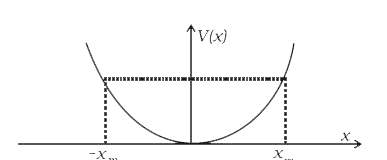The potential energy function for a particle executing linear SHM is given by V(x)=12kx2 where k is the force constant of the oscillator. For k=0.5Nm−1, the graph of V(x) versus x is shown in the figure A particle of total energy E turns back when it reaches x=±xm.if V and K indicate the potential energy and kinetic energy respectively of the particle at x=+xm,then which of the following is correct?

V=0,K=E
V=E,K=0
V<E,K=0
V=0,K<E
The correct Answer is:B
Total energy is E=PE+KE …(i)
When particle is at x=xm i.e., at extreme position,
returns back. Hence, at x=xm,x=0,KE=0
From Eq. (i) E=PE+0=PE=V(xm)=12kx2m
Similar Questions
The potential energy function for a particle executing linear simple harmonic motion is given by V(x)=kx22 where k is the force constant of the oscillator . For k=0.5Nm−1 , the graph of V(x) versus x is shown in figure . Show that a particle of total energy 1 J movng under this potential must 'turn back ' when it reaches x=±2m .

View SolutionThe potential energy function for a particle executing linear SHM is given by V(x)=12kx2 wher e k is the force constant of the oscillator (figure). For k = 0.5 N/m ,the graph ofV(x) versus x is shown in the figure . A particle of total energy E turns back when it reaches x=±xm . If V and K indicate the PE and KE , respectively of the particle at x=+xm , then which of the following is correct ?

View SolutionThe potential energy function for a particle executing linear SHM is given by V(x)=12kx2 where k is the force constant of the oscillator. For k=0.5Nm−1, the graph of V(x) versus x is shown in the figure A particle of total energy E turns back when it reaches x=±xm.if V and K indicate the potential energy and kinetic energy respectively of the particle at x=+xm,then which of the following is correct?

View SolutionWhen a particle executing SHM oscillates with a frequency v, then the kinetic energy of the particle,
View Solutionसरल आवर्त गति (SHM) करते किसी कण का स्थैितिज ऊर्जा फलन है - V(x)=12kx2 जहाँ k दोलित्र का बल नियतांक है। k = 0.5N/m के लिए V(x) और x का ग्राफ चित्र 6.2 में दर्शाया गया है। E ऊर्जा का कोई कण x=±xm पर पहुँच कर वापस लौटता है। यदि x=+xm पर V एवं K क्रमशः कण की स्थैितिज ऊर्जा (P.E.) एवं गतिज ऊर्जा (K.E.) निरुपित करते हों तो निम्नलिखित में कौन-सा कथन सही है?

View SolutionWhen a particle executes SHM oscillates with a frequency v, then the kinetic energy of the particle
View SolutionWhen a particle executing SHM oscillates with a frequency, v then the kinetic energy of the particle
View SolutionTo potential energy function for a particle executing linear simple harmonic motion is given V(x) = kx^(2) //2 , where k is the force constant of the oscillator . For k = 0.5 N m^(-1) the graph of V(x) versus x is shown in Fig. Show that a particle of total energy 1 J moving under this potential must 'turn back' when it reaches x = pm 2 m
View Solution

